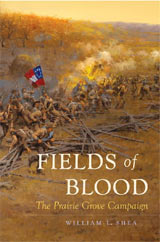The University of North Carolina Press, 2009
Trade Hardcover[/box]
 Bill Shea is no stranger to the Civil War community and is a respected historian that specializes in the Trans-Mississippi region. He has spent the majority of his academic career at the University of Arkansas-Monticello. To date his publications have been collaborative efforts with other respected historians such as Earl Hess (Pea Ridge) and Terry Winschel (Vicksburg). Those works are exceptional and the Pea Ridge tome remains the standard by which other works on that early campaign will be judged. Fields of Blood is his first solo effort—it shouldn’t be his last.
Bill Shea is no stranger to the Civil War community and is a respected historian that specializes in the Trans-Mississippi region. He has spent the majority of his academic career at the University of Arkansas-Monticello. To date his publications have been collaborative efforts with other respected historians such as Earl Hess (Pea Ridge) and Terry Winschel (Vicksburg). Those works are exceptional and the Pea Ridge tome remains the standard by which other works on that early campaign will be judged. Fields of Blood is his first solo effort—it shouldn’t be his last.
This book is noteworthy for its straight forward and readable prose. Few people understand the Trans-Mississippi and admittedly it is better understood if you have walked the fields. Shea has done that and I have been privileged enough to walk with him and to see him in action presenting this as a two day tour. That insight made this book an indispensable and easily understood narrative.
The Trans-Mississippi is the forgotten theater of war and this battle in December 1862 ensured that it was. The Federal success here followed on its victory at Pea Ridge (Elkhorn Tavern in March 1862) and it secured Missouri for the Union. The last hurrah in Missouri occurred later in 1864 as Missouri General Sterling Price engaged in a forlorn effort to recover the state for the Confederacy.
Tours of the Trans-Mississippi usually base themselves from Springfield, Missouri and devote a day each to Wilson’s Creek, Pea Ridge and Prairie Grove. Prairie Grove is the furthest from the base camp and it usually gets short service which belies its importance to the theater. Indeed it is a campaign that is integral to the control of Missouri. Pea Ridge is a disappointment to the Confederates—Prairie Grove is a crushing defeat.
Shea sets up the narrative with meaningful introduction to the antagonists: Thomas Hindman, Theophilus Holmes, James Blunt, John Schofield and Francis Heron. The relationships are well established and you immediately see the conflict between the ambitious Schofield and his subordinates and the aggressive Hindman and the cautious Holmes. The Wire Road is the superhighway of the war and operations along it will dictate the control of the region. The Boston Mountains are an impressive obstacle and screen which allow the Confederate army to loiter in proximity to any Federal forces in advance of the southern Missouri border.
Although I had walked he fields with Bill, I didn’t understand the interrelationship with the Federal forces at Cane Creek and those which moved to Prairie Grove. The failure of the Federal forces to unite nearly cost them the battle—still Hindman’s skill in keeping them separated merits admiration and study. On the other hand, the battle at Prairie Grove and the fight for the Borden House is superbly presented. The blood of the Iowans will forever consecrate the ground. The fierce counter attack of the Arkansans prevented a complete route; but, when Blunt arrived the Confederates were squarely between converging forces. Further engagements were futile and Hindman had to work to retire his forces in safety.
Shea understands that the reader needs closure and he completes the narrative with a meaningful and full description of the Confederate retreat. The finality of Federal success is punctuated with the Federal’s successful raid on Van Buren. The Confederates will withdraw to Little Rock leaving the Federals as the master of northwest Arkansas and Missouri.
Frankly, I cannot find any weaknesses with this book. I would ask Bill “What took so long?” He is an accomplished historian with a full mastery of his subject. This work finishes a fine series of books which define the war in Missouri. Combine this with Bill Piston’s and Rick Hatcher’s book on Wilson’s Creek and Shea and Hess’ book on Pea Ridge and you have a trilogy that should be read in sequence for maximum impact.
[box]Reviewed by Len Riedel, Executive Director, BGES, February 11, 2010.Disclosure: Bill Shea is my friend and a member of the Blue and Gray Education Society. As much as is possible this is an objective review.[/box]
